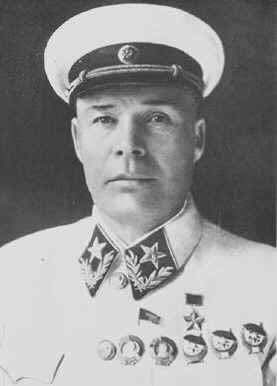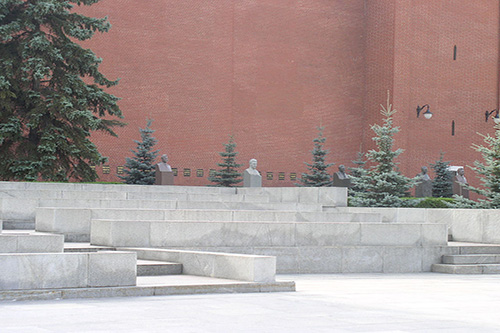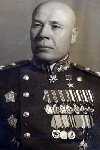Semyon K. Timoshenko
Semyon Konstantinovich Timoshenko was born on February 18th, 1895 in Furmanka (Bessarabia, the present Moldavia). As a child he worked at the farm of his parents until he was called up for military service in the Czarist army, in order to fight the Germans during World War One. He was sentenced to a few years in prison by a court martial for having insulted an officer. He managed to escape though and joined the Bolshevist Red Army in the civil war against the White Army.
He commanded several cavalry units, the 2nd Independent Cavalry Brigade, the 6th Cavalry Division and the 4th Cavalry Division in that order and in the end he was appointed commander of III Cavalry Corps, part of the famous 1 Cavalry Army commanded by Semyon M. Budyonny (Bio Budyonny). Timoshenko proved himself a master in mobile warfare. During the civil war, he also met Stalin (Bio Stalin) who was impressed by Timoshenko’s achievements.
In the early 30s, Timoshenko joined the General Staff of the Byelorussia Military District and afterwards the staff of the Kiev Military District until he was appointed commander of the Northern Caucasus Military District in 1937. He did not hold this function for long as he was named commander of the Karkov Military District that year. He did not remain there long either as he returned to Kiev, this time as commander of the district. In 1938, he was promoted to Marshal of the Soviet Union and he was one of the few high ranking officers who escaped Stalin’s Great Purge.
On September 17th, 1939, Timoshenko – in command of the 3rd Ukrainian front, crossed the Polish border and disarmed the weakened garrisons in eastern Poland. Losses on Soviet side were minimal as they hardly met any resistance. In January 1940, Timoshenko was given the task of replacing Marshal Voroshilov (Bio Voroshilov) as commander of the Soviet forces up north during the winter war against Finland. The Soviet forces had suffered defeat after defeat over there and Timoshenko arrived to straighten things out. He managed to drive the Finns out of the Karelian isthmus but at the cost of immense losses. In March 1940, a peace treaty was eventually signed with the Finns. Timoshenko remained in command of the northern front that now doubled as an army of occupation.
As war against Nazi Germany was looming, Timoshenko was promoted to supreme commander of the Soviet armed forces and named People’s Commissioner of Defense at the same time. He was charged with reorganizing and expanding the Red Army. This was an immense enterprise and he was a long way from finished when the Germans invaded the Soviet Union on June 22nd, 1941. Timoshenko issued the questionable order to the Soviet forces for a counter attack on June 23rd. This uncoordinated attack ended in failure and hundreds of thousands Soviet soldiers were surrounded and killed or taken prisoner. Afterwards, Timoshenko remained at headquarters in Moscow, advising Joseph V. Stalin on military matters.
On July 2nd, 1941, Timoshenko took command of the Western front and not long after of the Western Axis. In this capacity he conducted the battle for Smolensk, delaying the German drive to Moscow for two months, albeit at the cost of immense losses. In September that same year, he succeeded Semyon M. Budyonny as commander of the Southern Axis. Although it was too late to prevent the elimination of four surrounded armies near Kiev, he again managed to delay the German advance until it finally ground to a halt.
As commander of the Southwestern front (later renamed Stalingrad front) Timoshenko was given the task by Stalin to launch a massive offensive the next spring intended to recapture Karkov. Initially, the offensive proceeded successfully but Stalin intervened as to the strategy to be followed and the operation ended in disaster. The Soviet front in the south collapsed, enabling the Germans to reach Stalingrad and the northern region of the Caucasus. Timoshenko was relieved of his function but shortly afterwards, he was given command again of the Northwestern front. In July 1942, he was downgraded again by being relieved of this function also. He remained a member of Stavka though and in that capacity, he coordinated the operations of 2nd and 3rd Ukrainian fronts in their successful advance into the Balkans with their most conspicuous achievement being the capture of Vienna in 1945.
After the war, Timoshenko was awarded the following decorations: the Orden Pobeda (order of Victory) and the Orden Lenina (order of Lenin), in addition to many others. He also was officially named Hero of the Great Patriotic War and of the October Revolution. In 1961 however, Timoshenko was indicted for the fact the Red Army had not been ready for war at the time of the German invasion in 1941 but in the end he was not sentenced. During the final years of his life, Timoshenko was involved in various veterans organizations until his death on March 31st, 1970 in Moscow.
Read more about the decorations of this person on WW2Awards.com
Definitielijst
- Brigade
- Consisted mostly of two or more regiments. Could operate independently or as part of a division. Sometimes they were part of a corps instead of a division. In theory a brigade consisted of 5,000 to 7,000 men.
- cavalry
- Originally the designation for mounted troops. During World War 2 the term was used for armoured units. Main tasks are reconnaissance, attack and support of infantry.
- Great Patriotic War
- Soviet and Russian term for World War 2.
- invasion
- Armed incursion.
- Marshal
- Highest military rank, Army commander.
- Nazi
- Abbreviation of a national socialist.
- offensive
- Attack on a smaller or larger scale.
- Red Army
- Army of the Soviet Union.
- resistance
- Resistance against the enemy. Often also with armed resources.
- Revolution
- Usually sudden and violent reversal of existing (political) the political set-up and situations.
- Soviet Union
- Soviet Russia, alternative name for the USSR.
- Stavka
- The high command of the Russian military forces in World War 2, chaired by Stalin.
- strategy
- Art of warfare, the way in which war should be conducted in general.
Images
Information
- Article by:
- Tom Notten
- Translated by:
- Arnold Palthe
- Published on:
- 19-01-2025
- Feedback?
- Send it!
- 06-'42: Along the Battle Fronts
- 08-'42: Along the Battle Fronts
- 08-'42: Along the Battle Fronts
- 04-'43: Timoshenko Takes the Offensive in the North
The War Illustrated
Related sights
Sources
- Clark A., Barbarossa: The Russian-German Conflict 1941-1945, Weidenfeld & Nicholson, Londen, 1995 - Erickson J., The Road to Stalingrad: Stalin's War with Germany, Weidenfeld & Nicholson, Londen, 1975 - Zalleski K.A., Stalin's Empire: biographical encyclopedia, Moskou, 2000 - Marshals and Admirals of the Fleet of the Soviet Union











